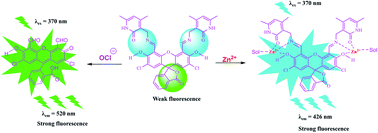Dual-mode chemosensor for the fluorescence detection of zinc and hypochlorite on a fluorescein backbone and its cell-imaging applications†
Abstract
Fluorescein coupled with 3-(aminomethyl)-4,6-dimethylpyridin-2(1H)-one (FAD) was synthesized for the selective recognition of Zn2+ over other interfering metal ions in acetonitrile/aqueous buffer (1 : 1). Interestingly, there was a significant fluorescence enhancement of FAD in association with Zn2+ at 426 nm by strong chelation-induced fluorescence enhancement (CHEF) without interrupting the cyclic spirolactam ring. A binding stoichiometric ratio of 1 : 2 for the ligand FAD with metal Zn2+ was proven by a Jobs plot. However, the cyclic spirolactam ring was opened by hypochlorite (OCl−) as well as oxidative cleavage of the imine bond, which resulted in the emission enhancement of the wavelength at 520 nm. The binding constant and detection limit of FAD towards Zn2+ were determined to be 1 × 104 M−1 and 1.79 μM, respectively, and the detection limit for OCl− was determined as 2.24 μM. We introduced here a dual-mode chemosensor FAD having both the reactive functionalities for the simultaneous detection of Zn2+ and OCl− by employing a metal coordination (Zn2+) and analytes (OCl−) induced chemodosimetric approach, respectively. Furthermore, for the practical application, we studied the fluorescence imaging inside HeLa cells by using FAD, which demonstrated it can be very useful as a selective and sensitive fluorescent probe for zinc.

- This article is part of the themed collection: Analytical Methods HOT Articles 2022


 Please wait while we load your content...
Please wait while we load your content...